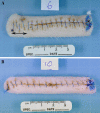Prolonged Analgesic Effect of PRF-108 and PRF-110 on Post-operative Pain in Pigs
- PMID: 26724813
- PMCID: PMC4912964
- DOI: 10.1007/s40122-015-0043-9
Prolonged Analgesic Effect of PRF-108 and PRF-110 on Post-operative Pain in Pigs
Abstract
Introduction: Local anesthetic infusion techniques have been reported to reduce opiate requirements and pain scores following different kinds of surgery, including orthopedic surgery, inguinal hernia, and Cesarean surgery in women.
Methods: PRF-108 and PRF-110 formulations were applied to the wound space in an incisional model in pigs to test the hypothesis that these formulations have better and longer analgesic effects than the commercially available ropivacaine solution (Naropin(®), AstraZeneca).
Results: The data show significantly better analgesic activity with PRF-108 and PRF-110 compared to ropivacaine. The duration of the analgesic efficacy of PRF-108 and PRF-110 was at least five times longer than that was measured following treatment with ropivacaine. The data further suggest that active clearance from the injection site (the wound) is much slower for PRF-108 and PRF-110 than for the commercial ropivacaine solution.
Conclusion: Assessing the local concentration of PRF compounds and commercially available ropivacaine solution suggests that active clearance from the injection site (the wound) is much slower for PRF-108 and PRF-110 than for ropivacaine.
Funding: PainReform.
Keywords: Incision; PRF-108; PRF-110; Pain; Pig; Ropivacain; Surgery.
Figures






References
-
- Aasbø V, Thuen A, Raeder J. Improved long-lasting postoperative analgesia, recovery function and patient satisfaction after inguinal hernia repair with inguinal field block compared with general anesthesia. Acta Anaesthesiol Scand. 2002;46(6):674–678. doi: 10.1034/j.1399-6576.2002.460607.x. - DOI - PubMed
LinkOut - more resources
Full Text Sources
Other Literature Sources

